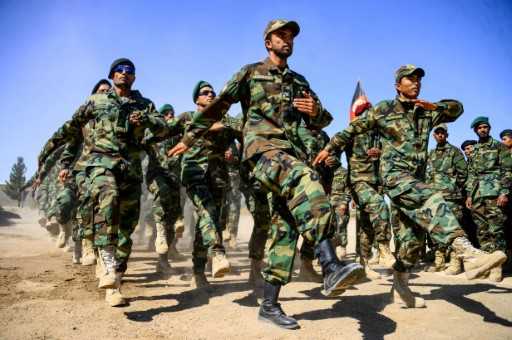Afghan forces face intense Taliban test as foreign troops leave
04 August, 2021

Taliban territorial gains have raised doubts about the Afghan military's strength with foreign troops all but gone -- a showdown between two very different forces in which experts say morale could be as decisive as equipment and personnel.
It is not a conventional military engagement, but one that pits a large army -- raised and equipped by a superpower -- against a smaller but well-supplied jihadist group backed by narco-dollars.
The United States has poured tens of billions of dollars into Afghanistan's defense forces, providing modern weapons and high-tech equipment, including night-vision goggles, attack helicopters, armoured vehicles and surveillance drones.
With more than 300,000 personnel -- police included -- it is bigger and more advanced than the Taliban, who are mainly a guerrilla infantry with no air force.
U.N. monitors estimated last year the insurgents had between 55,000 and 85,000 fighters.
But numbers alone do not tell the whole story.
The Taliban mainly use weapons found easily in war-torn Afghanistan or procured from the black market, such as variants of the AK-47 assault rifle and other Soviet-designed arms.
They have also captured Western-made weapons and equipment from the Afghan military, and have allegedly received material and advisory support from regional powers such as Iran and Pakistan.
"The style of fighting they employ is a lot less logistically intensive," said Jonathan Schroden, a counterterrorism expert at the military think tank CNA.
The insurgents also appear to have greater financial self-sufficiency. U.N. monitors said last year that the Taliban have annual revenues anywhere between $300 million and $1.5 billion, sourced from Afghanistan's huge narcotics industry, criminal activities, and taxation in areas they control.
The Afghan military, on the other hand, requires $5-6 billion annually. That comes almost entirely from external sources, mainly the United States.
Its air force gives it an unmatched weapon against the Taliban, but Afghanistan does not have enough personnel for maintenance -- a task mainly performed by U.S. contractors who are also leaving.
That could potentially ground Afghanistan's planes and helicopters within months, according to a U.S. military assessment in January.
The general in charge of the remaining American troops has said Afghan aircraft could be taken to a third country for maintenance and then flown back.
An unsustainable military, however large or well-equipped, could prove to be a disadvantage if foreign assistance dries up.
Brian Michael Jenkins at the RAND Corporation, a U.S. think tank, compared it to a suit of armour on display.
"If you look at it, it's steel armour, helmet, gloves, breastplate, everything. But of course they're hollow. They're propped up on a stick," he told AFP. "And if you were to go and give them a swift kick, the whole thing just falls over."
But some analysts said it would be rash to assume that the Afghan army will collapse right away.
Many of the areas lost to the Taliban recently were not under effective government control to begin with, they said, and the Afghan military's retreat could help it consolidate in urban areas where it has a defensive advantage.
The Taliban could find it much harder to break down such defenses with tactics and equipment that have worked in rural areas.
CNA's Schroden told AFP there could be a different dynamic in 2022 if "the government can hold off Taliban attacks against the provincial capitals for the rest of this fighting season".
That could prove a difficult task without U.S. air support.
The Pentagon has said it will maintain an "over-the-horizon" capability to target threats to U.S. security, but it remains unclear if that includes regular air strikes.
Morale may be a decisive factor.
While analysts say the Taliban have displayed strong cohesion, the Afghan military has been plagued for years by poor leadership, heavy losses, corruption and low motivation.
And the latest Taliban offensives have dealt further psychological damage.
"Even if the government had intended to let some districts fall... the damage to morale of the security forces and of the nation of seeing districts toppling like dominoes cannot be underestimated," Kate Clark of the Afghanistan Analysts Network wrote in an assessment last month.
The "profound sense of abandonment" caused by the departure of American forces could lead to demoralized Afghan soldiers considering their own survival, said RAND's Jenkins.
"And they're making those individual decisions not on the basis of national interest or a national strategy... (but) 'Where do I come out in all of this? And am I best served by being the last man standing here between the Taliban and the national palace in Kabul?'"
Source: japantoday.com
TAG(s):
